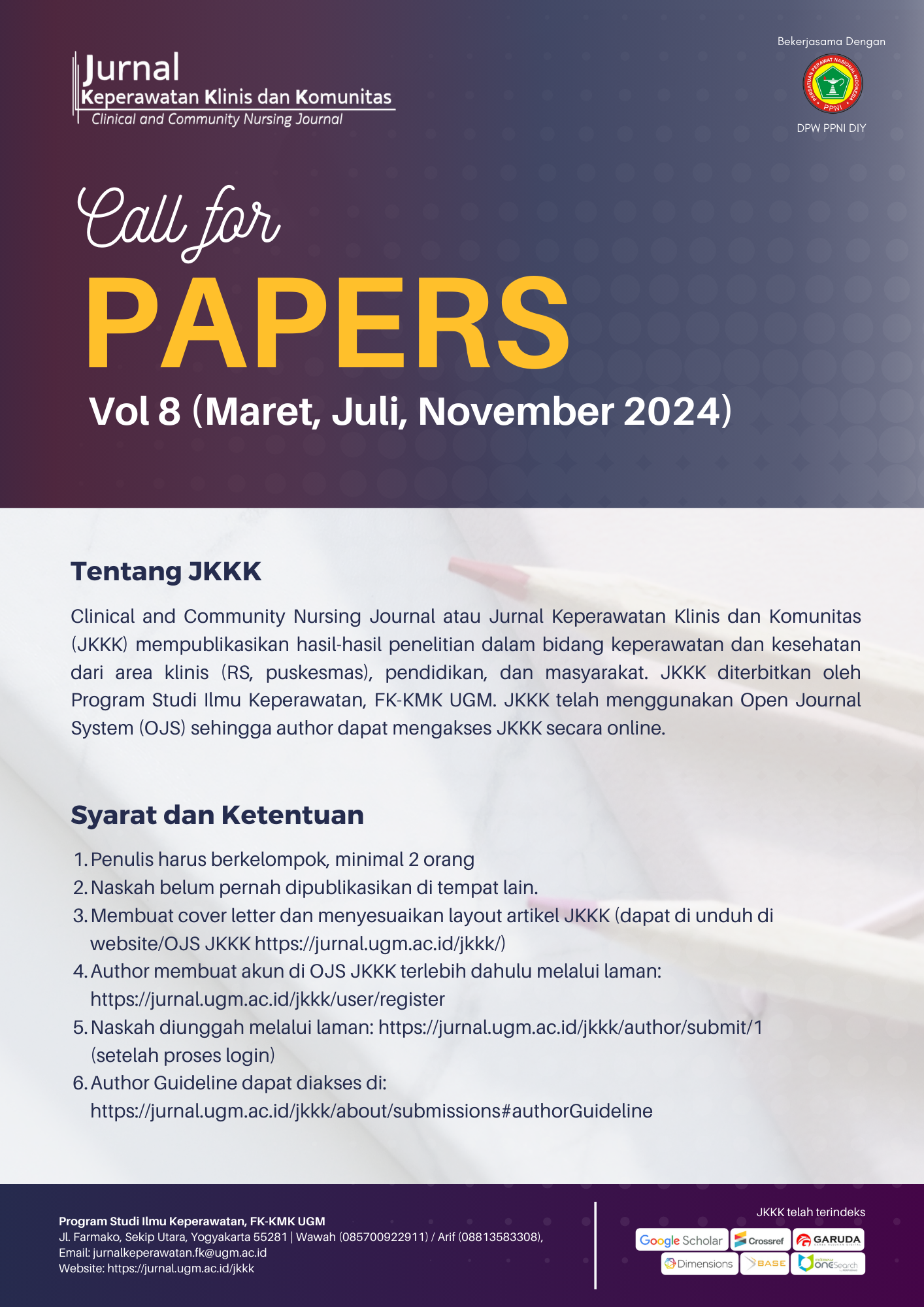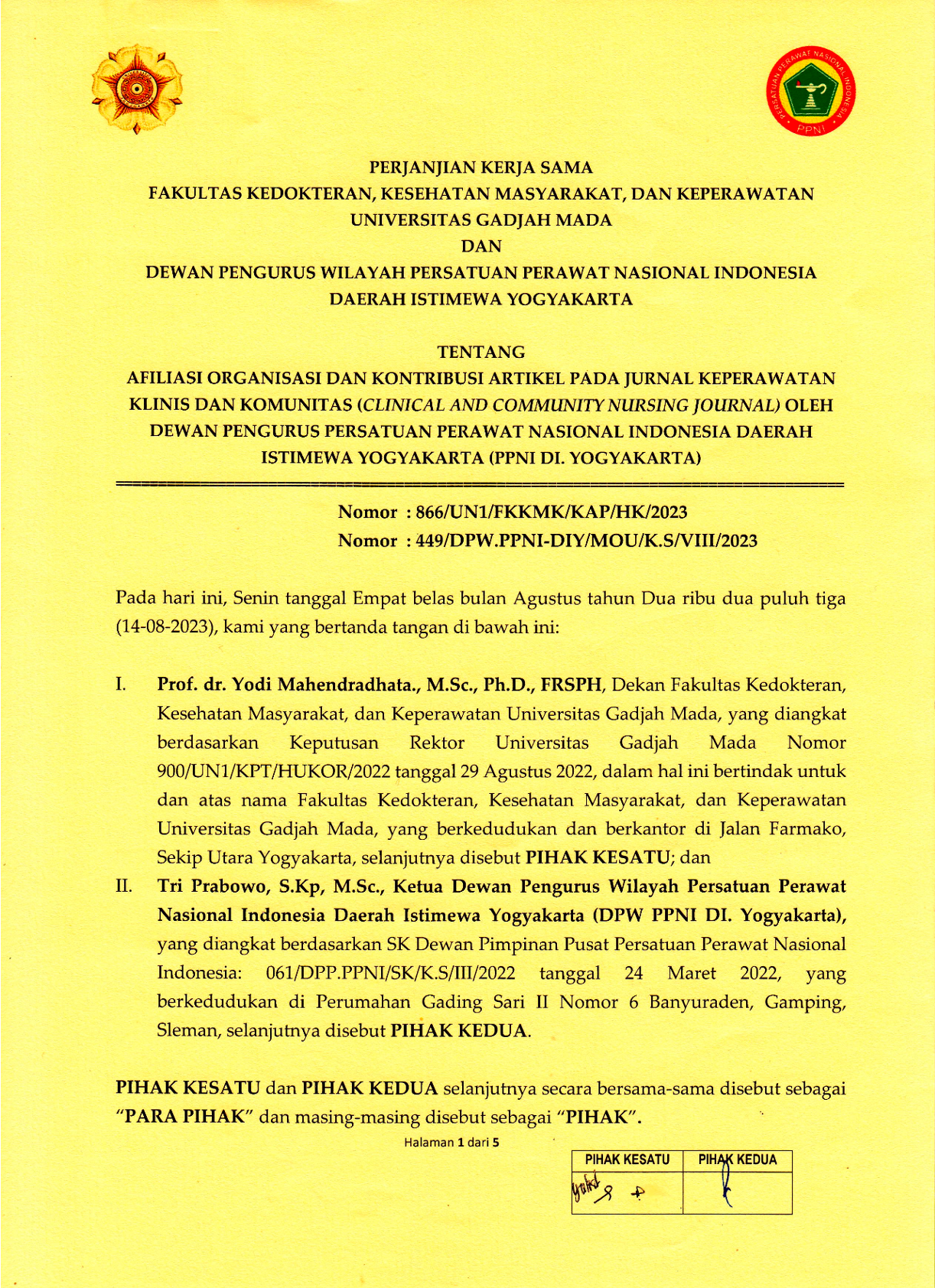Gambaran Tingkat Kecemasan pada Korban Banjir Bandang di Kabupaten Magelang
Dewa Ayu Made Dewi Widhayanti(1), Sri Warsini(2*), Sutono Sutono(3)
(1) Program Studi Ilmu Keperawatan, Fakultas Kedokteran, Kesehatan Masyarakat, dan Keperawatan, Universitas Gadjah Mada
(2) Departemen Keperawatan Jiwa dan Komunitas, Fakultas Kedokteran, Kesehatan Masyarakat, dan Keperawatan, Universitas Gadjah Mada
(3) Departemen Keperawatan Dasar dan Emergensi, Fakultas Kedokteran, Kesehatan Masyarakat, dan Keperawatan, Universitas Gadjah Mada
(*) Corresponding Author
Abstract
Background: Indonesia is one of the countries that is prone to flood disaster. The flash flood that occurred in Magelang on April 29th 2017 had caused a major physical loss, such as houses damage, dead casualties, injured victims, and displacement. In addition to the physical loss, flood disaster may impact mental health of the victims e.g. stress, anxiety, depression and post-trauma stress disorder.
Objective: This research was aimed to identify the anxiety level of the victim of flood at Sambungrejo and Citrosono villages and the difference of anxiety level of flood victim based on the characteristics of the respondents.
Methods: This research was a descriptive research with a cross sectional design. A cluster sampling was performed to get 100 respondents who were victim of flood in Sambungrejo and Citrosono villages, which met the inclusion and exclusion criteria of this study. The instruments used in this study were Zung Self Anxiety Scale (ZSAS) and socio-demographic questionnaire. The data were analyzed using Fisher test.
Results: The research found that 91% of respondents did not suffer anxiety, while the rest of the respondents (9%) suffered mild - moderate anxiety, thus no respondents suffered severe anxiety. The variation of respondent anxiety level occured based on evacuation record at p value = 0,026.
Conclusion: Overall, the flood victims in Sambungrejo and Citrosono villages did not suffer anxiety. Among all factors, evacuation record correlated with the anxiety level of respondents.
ABSTRAK
Latar Belakang: Indonesia merupakan salah satu negara yang rawan terhadap bencana banjir. Banjir bandang yang terjadi di Magelang pada 29 April 2017 menimbulkan kerugian berupa kerusakan rumah, korban meninggal, korban luka–luka dan mengungsi. Selain dampak secara fisik, banjir dapat memberikan dampak bagi kesehatan mental berupa stres, kecemasan, depresi, dan gangguan stres pascatrauma.
Tujuan: Penelitian ini bertujuan untuk mengetahui tingkat kecemasan korban di Desa Sambungrejo dan Citrosono setelah banjir bandang dan mengetahui perbedaan tingkat kecemasan berdasarkan karakteristik responden.
Metode: Penelitian ini merupakan penelitian deskriptif dengan rancangan cross sectional. Sampel pada penelitian ini adalah korban banjir bandang di Desa Sambungrejo dan Citrosono yang memenuhi kriteria inklusi dan eksklusi sejumlah 100 orang. Teknik sampling yang digunakan adalah cluster sampling. Instrumen yang digunakan adalah Zung Self-Rating Anxiety Scale (ZSAS) dan kuesioner karakteristik responden. Analisis data menggunakan uji Fisher.
Hasil: Hasil penelitian menunjukkan 91% responden tidak mengalami kecemasan, sisanya sebanyak 9% responden mengalami kecemasan ringan hingga sedang, dan tidak ada responden yang mengalami kecemasan parah. Tingkat kecemasan responden hanya berbeda berdasarkan riwayat mengungsi dengan nilai p = 0,026.
Kesimpulan: Secara keseluruhan korban banjir bandang di Desa Sambungrejo dan Citrosono tidak mengalami kecemasan. Dari semua faktor yang ada, hanya riwayat mengungsi yang berhubungan dengan tingkat kecemasan responden.
Keywords
Full Text:
PDFReferences
- Data dan Informasi Bencana Indonesia. Statistik Bencana Indonesia 2016 [Internet]. 2017 [diakses pada 19 Januari 2017 pukul 09.19 WIB]. Diakses dari: https://www.dibi.bnpb.go.id
- Badan Meteorologi, Klimatologi dan Geofisika. "Musim Kemarau Tahun ini, La -Nina diprediksi muncul" [Internet]. 2016 [diakses pada 08 April 2016 pukul 20.32 WIB]. Diakses dari: http://www.bmkg.go.id/berita/?p=musim- kemarau-tahun-ini-la-nina-diprediksi-muncul&lang=ID.
- Detik News. Banjir Bandang di Magelang, 170 Jiwa Harus Mengungsi [Internet]. 2017 [diakses pada 02 Mei 2017 pukul 12.17 WIB]. Diakses dari: https://news.detik.com.
- Metro TV News. Korban Banjir Bandang Magelang ditemukan, Total 13 Tewas [Internet]. 2017 [diakses pada 02 Mei 2017 pukul 12.17 WIB]. Diakses dari: https://www.metrotvnews.com.
- Tapsell & Tunstall. "I Wish I’d Never Heard of Banbury”: The Relationship Between Place and The Health Impacts from Flooding. Health & Place. 2008;14(2):133-15.
- Lamba, C. T. Gambaran Tingkat Kecemasan pada Warga yang Tinggal di Daerah Rawan Banjir Khususnya Warga di Kelurahan Tikala Ares Kota Manado. Jurnal E-Clinic. 2017;5:1–5.
- Dai, W., Kaminga, A. C., Tan, H., Wang, J., Lai, Z., Wu, X., & Liu, A. Long-term Psychological Outcomes of Flood Survivors of Hard Hit Areas of the 1998 Dongting Lake Flood in China : Prevalence and Risk Factors. 2017;1–14. https://doi.org/10.1371/journal.pone.0171557.
- Katona, C., Cooper, C., Robertson, M. At a Glance Psychiatry Edisi Keempat. Jakarta: Erlangga; 2012.
- Zung, W.W. A Rating Instrument for Anxiety Disorders. Psychosomatics. 1971;12(6):371-9. http://dx.doi.org/10.1016/S0033-3182 (71)71479-0.PMID: 517292.
- Videbeck, S.L. Psychiatric–Mental Health Nursing Fifth Edition. China: Lippincott Williams & Wilkins; 2011
- Karimah, R. Trauma Healing oleh Muhammadiyah Disaster Management Center untuk Anak Korban Bencana (Studi Kasus Bencana Tanah Longsor di Desa Sampang, Kecamatan Karangkobar, Banjarnegara, Jawa Tengah 2014) [Skripsi]. Yogyakarta: UIN Sunan Kalijaga; 2015 [disitasi pada Maret 2018]. Diakses dari: http://digilib.uin-suka.ac.id/17925/.
- Munro, A., Kovats, R.S., Rubin, G.J. Effect of Evacuation and Displacement on The Association between Flooding and Mental Health Outcomes: a Cross-Sectional Analysis of UK Survey Data; 2017.
- Shaw, M. Housing and Public Health. Annual Review Public Health. 2004;25:397–418.
- Lancet Planet Health. Flooding-Related Displacement and Mental Health. The Lancet Planetary Health. 2017;1(4). http://dx.doi.org/10.1016/S2542- 5196(17)30047-5.
- Ma, N., Ma, H., He, H., Yu, X., Caine, E.D. Characteristics of Wenchuan Earthquake Victims Who Remained in a Government-Supported Transitional Community. Asia Pacific Psychiatry. 2013;5(2):E73-80. doi: 10.1111/appy.12074.
- Aslam, N., & Kamal, A. Disorder among General Population Affected by Floods. Pakistan Journal of Medical Research. 2016; 55(1):29–33.
- Yokoyama, Y., Otsuka, K., Kawakami, N., Kobayashi, S., Ogawa, A., Tannno, K., Onoda, T., Yaegashi, Y. & Sakata, K. Mental Health and Related Factors after the Great East Japan Earthquake and Tsunami. PLOS ONE. 2014;9(7): e102497.
- Velden, P.G., Wong, A., Hendriek, C., Boshuizen, & Grievink, L. Persistent Mental Health Disturbances during The 10 years after a Disaster: Four-wave Longitudinal Comparative Study. Psychiatry and Clinical Neurosciences. 2013; 67:110–118. doi: 10.1111/pcn.12022.
- Warsini, S., Buettner, P., Mills, J., West, C., & Usher, K. Post-Traumatic Stress Disorder among Survivors Two Years after The 2010 Mount Merapi Volcano Eruption: A Survey Study. Nurse Health Sci. 2014. doi: 10.1111/nhs.12152
- Abdullah, S., Sipon, S., Nazli, N.N., Puwasa, N.H. The Relationship between Stress and Social Support among Flood Victims. Procedia. 2015;192:59-64.
- Bei, B., Bryant, C., Gilson, K.M., Koh, J., Gibson, P., Komiti, A., Jackson, H., Judd, F. A Prospective Study of The Impact of Floods on The Mental and Physical Health of Older Adults. Aging Mental Health. 2013;17(8):992-1002. doi: 10.1080/13607863.2013.799119.
- Dai, W., Kaminga, A. C., Tan, H., Wang, J., Lai, Z., Wu, X., & Liu, A. Long-term Psychological Outcomes of Flood Survivors of Hard Hit Areas of the 1998 Dongting Lake Flood in China : Prevalence and Risk Factors. 2017:1–14. https://doi.org/10.1371/journal.pone.0171557.
- Suzuki, Y., Yabe, H., Yasumura, S., Ohira, T., Niwa, S., Ohtsuru, A., Mashiko, H., Maeda, M., & Abe, M. Mental Health Group of the Fukushima Health Management Survey. Psychological Distress and The Perception of Radiation Risks: The Fukushima Health Management Survey. Bulletin of The World Health Organization. 2015;93: 598–605.
- Murakami, M., Nakatani, J., & Oki, T. Evaluation of Risk Perception and risk comparison information regarding dietary radionuclides after the 2011 Fukushima nuclear power plant accident. PLoS One. 2016;11:e0165594.
- Fukasawa, M., Kawakamia, N., Umedaa, M., Miyamotoa, K., Akiyamab, T., Horikoshic, N., Yasumurad, S., Yabee, H., Brometf, E.J. Environmental radiation level, radiation anxiety, and psychological distress of non-evacuee residents in Fukushima five years after the Great East Japan Earthquake: Multilevel analysis. Population Health. 2017;740–748. http://dx.doi.org/10.1016/j.ssmph.2017.09.002.
- Asa, P., Ramirez, M., Young, T., Cao, Y. Flood-Related Work Disruption and Poor Health Outcomes among University Students. Prehosp Disaster Med. 2012;27(6):503-8. doi: 10.1017/S1049023X1200129X.
- Waite, T.D., Chaintarli, K., Charles R., Bone, A., Amlôt, R., Kovats, S., Reacher, M., Armstrong, B., Leonardi, G., Rubin, J. & Oliver, I. The English National Cohort Study of Flooding and Health: Cross-Sectional Analysis of Mental Health Outcomes at Year One. BMC Public Health. 2017;17:129. doi: 10.1186/s12889-016-4000-2.
- Rashidinejad, M., Dehghan, M., Tirgari, B., Rafiei, H. & Iranmanesh, S. General Health among Parents Who Lost Their Children in The Bam Earthquake. Global Journal of Health Science. 2015;7(5).
- Pawatte, I., Pali, C., Opod, H. Perbedaan Tingkat Kecemasan pada Ibu Pre Seksio Caesarea di RSIA Kasih Ibu dan RSUP Prof. Dr. R.D. Kandou Manado. Jurnal Kedokteran Komunitas dan Tropik. 2013;1(3):107–12.
- Xu, Y., Herrman, H., Bentley, R., Tsutsumi, A., & Fisher, J. Effect of Having a Subsequent Child on The Mental Health of Women Who Lost a Child in The 2008 Sichuan Earthquake: A Cross Sectional Study. Bull World Health Organ. 2014;92:348-355. http://dx.doi.org/10.2471/BLT.13.124677.
- Endike, S., Yaunin, Y., Serniaty, R. Hubungan Risiko Tsunami terhadap Tingkat Ansietas pada Anak- anak di SDN 02 Ulak Karang Selatan (Zona Merah) dan SDN 33 Kalumbuk (Zona Hijau). Jurnal Kesehatan Andalas. 2016; 5(2).
- Junaidi, R., Nurdin, A. E., & Rasyid, R. Gambaran Angka Kejadian Gangguan Ansietas pada Warga Batu Busuk Kelurahan Padang Besi Kecamatan Lubuk Kilangan Kota Padang Akibat Banjir Bandang 24 Juli 2012. Jurnal Kesehatan Andalas. 2015;4(2):519–523.
- Yoda, T., Yokoyama, K., Suzuki, H., Hirao, T. Relationship Between Long-term Flooding and Serious Mental Illness After the 2011 Flood in Thailand. Disaster Med Public Health Prep. 2017;11(3):300-304. doi: 10.1017/dmp.2016.148.
- Maclean, J.C., Popovici, I., & French, M.T. Are Natural Disasters in Early Childhood Associated with Mental Health and Substance Use Disorders as an Adult. Social Science & Medicine. 2016;151:78-91. https://doi.org/10.1016/j.socscimed.2016.01.006.
- Guimaro, M.S., Steinman, M., Kernkraut, A.M., Santos, O. F. P., Shirley Silva Lacerda, S.S. Psychological Distress in Survivors of The 2010 Haiti earthquake. Journal of Proquest. 2013;(11):11-13.
- Kristensen, P., Weisaeth, L., Hussain, A., Heir, T. Prevalence of Psychiatric Disorders and Functional Impairment after Loss of a Family Member: a Longitudinal Study after The 2004 Tsunami. Journal of Depress Anxiety. 2015;32(1):49-56. doi:10.1002/da.22269.
- Guimaro, M.S., Steinman, M., Kernkraut, A.M., Santos, O. F. P., Shirley Silva Lacerda, S.S. Psychological Distress in Survivors of The 2010 Haiti Earthquake. Journal of Proquest. 2013;(11):11-13.
- Pan, Liu, W., Deng, G., Liu, T., Yan, J., Tang, Y., Dong, W., Cui, Y. & Xu, M. Symptoms of Post-Traumatic Stress Disorder, Depression, and Anxiety Among Junior High School Students in Worst-Hit Areas 3 Years After the Wenchuan Earthquake in China Xiao. Asia Pacific Journal of Public Health. 2015;27. doi: 10.1177/1010539513488625
- Neria & Shultz. Mental Health Effects of Hurricane Sandy: Characteristics, Potential Aftermath, and Response. JAMA. 2012;26;308(24): 2571–2572. doi:10.1001/jama.2012.110700.2012.
- Cribbin, W. L., Liu, B., Schneider, S., Schwartz, R., Taioli, E. Self-Reported and FEMA Flood Exposure Assessment after Hurricane Sandy: Association with Mental Health Outcomes. 2017.
- Schwartz, R.M., Sison, C., Kerath, S.M., Murphy, L., Breil, T., Sikavi, D., Taioli, E. The impact of Hurricane Sandy on the Mental Health of New York Area Residents. Am J Disaster Med. 2015;10(4):339-46. doi: 10.5055/ajdm.2015.0216.
- Stephenson, J., Vaganay, M., Cameron, R., Joseph, P. The Long-Term Health Impacts of Repeated Flood Events. WIT Transactions on Ecology and The Environmental. 2014;184:201- 212. doi:10.2495/friar140171.
Article Metrics
Refbacks
- There are currently no refbacks.
Copyright (c) 2018 Dewa Ayu Made Dewi Widhayanti, Sri Warsini, Sutono

Jurnal Keperawatan Klinis dan Komunitas (Clinical and Community Nursing Journal)
collaborates with DPW PPNI DIY
![]()
Jurnal Keperawatan Klinis dan Komunitas (Clinical and Community Nursing Journal) is licensed under a Creative Commons Attribution-ShareAlike 4.0 International License.




